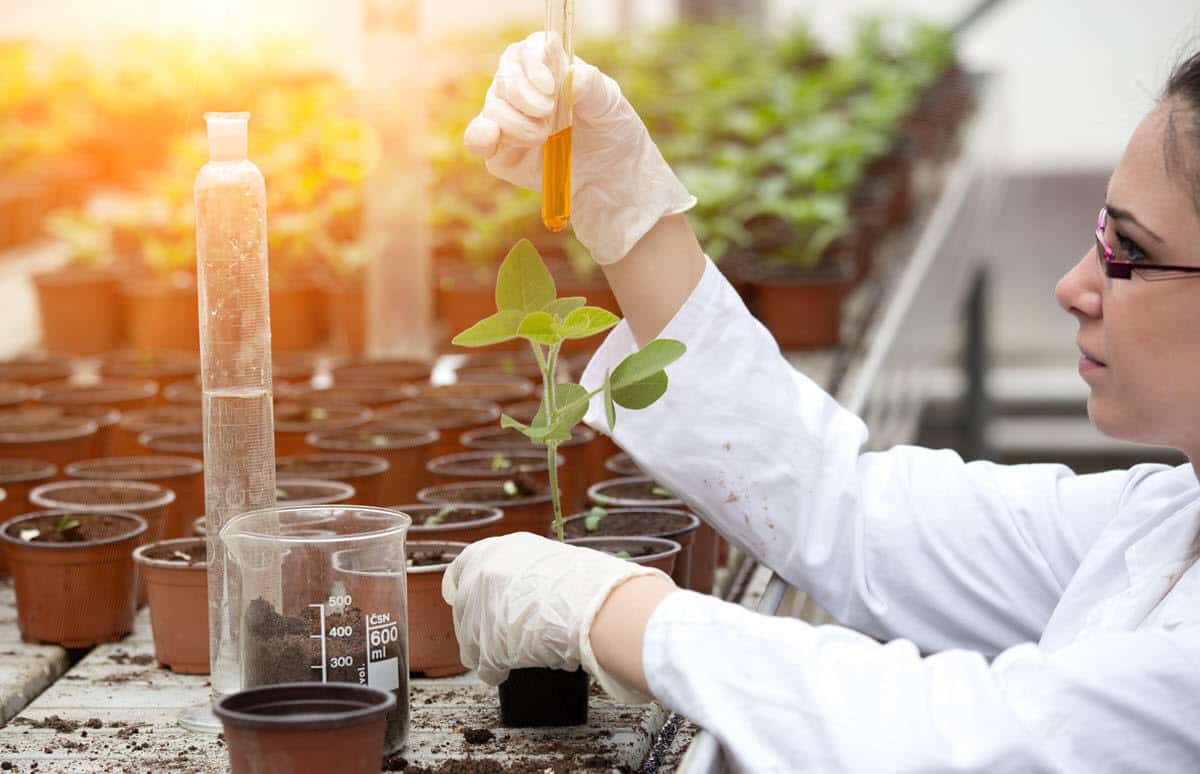Today’s Agriculture is Facing Unprecedented Challenges
It’s been over 50 years since the Green Revolution transformed agriculture – increasing farm yields and reducing food insecurity worldwide.
But what will agriculture and the world’s food supply look like in 50 years?
To be honest, ag experts around the world are worried.
A combination of climate change, irreparable damage to fragile topsoil ecosystems, and farmland lost to urbanization points to an uncertain future, with some economic forecasters predicting a return to widespread famine and food insecurity throughout the world.
Earlier Growing Seasons with Higher Temperatures but More Unpredictable Freezes and Devastating Storms
Here at home, growers – from large scale-agribusinesses to casual home gardeners – have noticed a steady change in the seasons, with insect and bird migrations signaling the change of seasons coming a few days sooner each year.
In much of the North American climate, climate change comes in the form of a warmer, longer growing season.
But with the increased temperatures have come more devastating and unpredictable storms, such as the hurricane-force derecho, which swept across Iowa farmlands (and other adjacent Midwest states) in August 2020, destroying much of the corn crop and causing $11 billion in damages.
Some also point to the Great Texas Freeze in February 2021 as an example of climate change, in which an arctic polar vortex plunged the state into prolonged darkness, thanks to cold temperatures which overwhelmed the energy grid infrastructure and killed livestock and crops across the region, including citrus trees in the Rio Grande Valley.

Can We Cope with a Sustained Mega Drought Across the West?
Higher summer temperatures are causing environmental damage, particularly in the West, which has faced widespread wildfire damage, threatening homes and agricultural areas alike, from vineyards in Napa Valley to grazing lands in Oregon.
One question worrying climate experts is whether the higher temperatures and the accompanying drought (exacerbated by a perennial lack of snowpack buildup during the winter) presages a new, drier era across the West.
The concern is that we may be entering a centuries-long period of “mega drought” similar to what may have brought an end to the golden era of Mayan culture in Mexico and Central America.
The low lake levels of Lake Mead outside Las Vegas underscore how dire the situation is. The Colorado River, which supports the water needs of businesses, homes, and agriculture, is no longer able to meet the combined needs of Los Angeles, Arizona, Nevada, and Mexico.
Western farmers, heavily dependent on irrigation and water-thirsty crops, such as almonds, have fought hard to maintain water rights, but they’ve also responded by digger deeper wells, driving the water table in places like California’s San Joaquin Valley to unsustainably low levels.
Heavier Rain and Flash Floods Spell Disaster for Crops in the Ground
The drought story is markedly different across much of the Mississippi valley, the Southeast states, and up the Atlantic coast. Climatologists point out that, on average, we are seeing cloudier days across these regions combined with a notable uptick in rain.
And the rain is heavier, often violent, leading to devastated washed-out crop fields.
Coastal flooding is also a growing issue, and saltwater is penetrating the water table in coastal citrus growing areas, such as Florida.
Adding to the misery for farmers is an increase in the number of major hurricanes, such as the recent Hurricane Ida, which skirted past New Orleans, devastating the rich seafood fishing areas along the coast – then sweeping up to the Northeast flooding surprised residents, leading to a loss of life.
Flooding, as we’ll discuss below, can have devastating, long-term effects on ag land, particularly when petrochemical refineries become flooded and release uncontained oil and chemical products into the floodwaters.
Soil Testing Laboratories Helped Bring Us the Green Revolution of the 1950s…

Since the heyday of the 1950s and 1960s, most soil testing laboratories have been supporting the key principles of the Green Revolution, which improved crop yields around the world.
Here is a short recap of developments that drove the Green Revolution in agriculture:
- Sophisticated plant nutrient/soil composition analysis
- Introduction of new crop varieties for higher yields
- Improved erosion and soil management techniques, including proper tilling, crop rotation, and flood control (dams and levees)
- The widespread introduction of petro-chemical based fertilizers
- Use of water pumps and plant irrigation systems
- Development of new pesticides
… But Today’s Environmental Challenges Call for New Innovations in Agricultural Science and Soils Management
The question before us is whether the status quo is good enough for the new environmental challenges.
Will we have to resort to revolutionary, unorthodox approaches to agriculture to keep feeding the world?
Many climate scientists and ag specialists say yes, particularly if our planet’s mean temperature continues to rise unabated.
Famine for much of the world is not out of the question.
So the question becomes, what can soil testing laboratories do now to help?
What are the key business opportunities that these labs can take advantage of to adapt to the new climate reality?
Here are ten ideas to consider.
1. Build on the Success of Current Consumer Demand for Organic Farm Produce
The widespread adoption of organic farming techniques by mainstream producers is one of the major agricultural success stories of the 20 years – thanks in no small part to the efforts of soil testing laboratories to certify that the soil and water sources conform to current organic farming regulations and standards.
With retail giants, such as Walmart, now carrying organic produce, there is a business opportunity for testing laboratories to encourage greater consumer adoption of organic standards to other lucrative sectors as well, such as certified organic wines, sustainably sourced water-based beverages, or even organic cannabis/cbt products.
2. Support Changing Consumer Tastes: Less Meat, More Veggies
Probably, the next biggest growth area for soil testing laboratory centers around the growing customer preference for vegetable-based protein over conventional meat-based protein sources – due to a combination of factors, including the preference for “clean eating” as well as a desire to reduce one’s personal global footprint (a plant-based diet creates far fewer greenhouse gas emissions than one based on livestock animals).
How will we get there?
Researchers point out that one place to start that could make a big difference in promoting plant-based protein for feeding our pets, such as cats and dogs. Soil into testing laboratories can help support this kind of initiative by ensuring that plant-based animal feeds for our pets are both safe and nutritious.
3. Cultivate New Protein Sources
During the Green Revolution, horticulturalists and soil testing laboratories worked together to create new varieties of plants that could provide more protein and increased yields per acre of planting.
We need to redouble our efforts to create crops that can help farmers adapt to changing environmental conditions, including increased droughts, floods, and shifts in temperatures and growing seasons.
But there’s more that can be done.
Soil and food testing laboratories are at the forefront of so-called “artificial meat” products, which have the taste and umami qualities of natural meat (including “blood”) but are made at scale in laboratory-style kitchens. For more information on how testing laboratories are involved in this rapidly expanding market sector, see our recent report.
Aquaculture is another growth area that soil testing laboratories may want to consider expanding into, particularly those with existing expertise in water quality testing.
Finally, we come to the topic of insects. Insects are an abundant source of protein – although they are met with repulsion in most Western cultures, they are a staple food source in many parts of Asia and Africa, and no wonder: they can provide a sustainable source of protein at a very low cost. Developments in this area for something that soil testing laboratories will want to watch carefully as consumer preferences continue to shift toward sustainable products, even ones currently deemed as unpalatable.
4. Manage and Conserve Water Supplies and Reduce/Recycle Human and Livestock Waste
The Green Revolution helped bring about the widespread introduction of irrigation methods worldwide, helping to increase production yields dramatically.
As the climate changes, the challenge of managing water becomes more critical. In many places, there is simply not enough water to irrigate with traditional methods.
Soil laboratories can help by developing new methods of horticulture, from promoting swale zones in farm fields that capture excess rainwater to developing new plant species that require less water while still maintaining productive yields.
Scientists working with soil testing laboratories are also developing new technologies for amending soils so that they can retain moisture and resist the drying effect of evaporation.
We are also going to have to take a hard look at reducing and recycling both human and livestock waste.
While many point to solar-powered reverse osmosis desalinization plants as a possible solution for water shortages, we can’t overlook the vast amount of water that’s used in human and livestock sanitation.
When it comes to ag waste, highly concentrated pig farming is an especially large issue, as concentrated pig waste can be released into the environment (with long-term devastating effects) during flooding events, such as tropical storms or hurricanes.
New technology is needed to upcycle this waste and transform it into a productive resource.
The same goes for human waste; proven technology for recycling human effluent is already in use in desert areas and could be implemented as a water-saving measure in more areas, leaving more water for life-sustaining agricultural activities.
Unfortunately, as we mentioned at the start, too much water (in the form of flooding rains or saltwater incursion in coastal areas) can be a problem as well. We clearly need new plant varieties that can better withstand pounding winds and flooding rains.

5. Develop More Sustainable Techniques for Weed and Pest Control
The organic food growing revolution has taught us all a lot about sustainable growing practices – without the use of artificial chemicals and pesticides.
However, there is still more to do.
Glyphosate-based herbicides (sold under brand names such as RoundUp) remain the most popular herbicides used in the USA – despite well-publicized multi-million dollar judgments against the German company Bayer (which purchased Monsanto, the developer of Roundup) for causing cancer to those exposed to the product.
Scientific curiosity and invention will hopefully save the day.
For example, many small-scale organic farmers are adopting growing methods once used by Native Americans, such as planting corn, beans, and squash in close proximity. Known as the “three sisters,” plant species combinations such as these help ward off invasive insect damage.
Robot planters and robotic weeders (equipped with electronic vision systems) may also prove to be another key advance in improving crop yields without having to resort to chemical pest controls.
6. Stop Farmland Top Soil Loss and Improve Crop Yields with Healthy Biome-Friendly Soil Amendments and Fertilizers
Farmers and soil researchers agree – the loss of precious topsoil is absolutely criminal.
They know it takes a special combination of geographic and environmental conditions – built up over the ages – to create productive topsoil.
Yet what took Mother Nature thousands of years to create can be lost in just a few years’ time – or even a few days – due to poor soil management or disasters such as flash flooding or industrial contamination.
Farmland with good topsoil is also falling victim to increased urbanization, with prime ag land around the world being turned over one last time to create new suburban homes and exurb cities.
The Green Revolution also brought us increased harvest yields worldwide, thanks to the widespread introduction of artificial fertilizers, many of which are derived from byproducts of the petrochemical industry.
But where do these artificial fertilizers and soil amendments fit in today’s more environmentally sensitive world?
For example, what do we do about fertilizer runoff that travels down streams and rivers to the oceans, creating oxygen-starved dead zones where no fish can live?
Given this new set of conditions, we are in desperate need of new soil amendment technologies to help regenerate and replenish depleted soils, using sustainable products that don’t rely as much on fossil fuels to make them.
7. Test and Remediate Brownfield Contamination in Soil and Water Supplies
With a growing world population and urban centers taking over prime land, where are we going to house our people and grow our crops?
One answer may lie in rehabilitating polluted brown lands, including the so-called Superfund sites.
This is another potential growth area for soil testing laboratories, who can profit from ramping up their testing and remediation services as the Federal government dedicates more money to cleaning up long-standing industrial pollution sites – as well as emerging dangers from forever chemicals released during manufacturing, storage, or even fracking for oil and gas.
Removing many of these chemicals, such as PCBs and Dioxins, has proven to be a difficult job, especially from waterways.
There are many opportunities to develop new technologies to remove pollution in the environment, and soil testing laboratories can have a front-row seat.
Perhaps the development of new varieties of plants, such as mustard which has the inherent ability to remove heavy metals from the soil, can be developed to improve the efficacy and reduce the cost of these cleanup efforts, allowing these lands to be used productively once again for housing or even farmland.

8. Build an Ideal Biome for Growing Plants with Artificial Soils and Hydroponics
Given the daunting environmental conditions facing farmers today, there’s no wonder that many ag entrepreneurs are eyeing hydroponic greenhouse gardening methods as the wave of the future.
Even home gardeners are experimenting with growing microgreens at home, using artificial lights and liquid growing mediums.
Growth in this area makes it a promising sector for soil testing laboratories, which can use their expertise to validate (or even certify) the artificial growing mediums.
As always, the challenge is to avoid insect damage and the typical pests, including mold and fungus.
On the other hand, there is plenty of upside to tweak the hydroponic plant growing process, either by developing new plant varieties that thrive in soil-less growing conditions as well as adding special nutrients or healthful minerals to the growing medium for the plants to uptake.
9. Support Sustainable Bio-Energy Production
Transitioning to a low-carbon economy to help stave off the worst effects of climate change is challenging.
One thing that we are all learning about is “interconnectedness,” in other words, how one activity can have an unintended consequence somewhere else.
Learning about these connections and how to manage them is a key emerging 21st-century skill.
And so too does this apply in agriculture, horticulture, and aquaculture.
Waste in one area needs to be repurposed whenever possible to serve the needs of something else.
What do we mean by this?
In the case of soil testing laboratories, it could mean several things.
For example, scientific research might show that it’s more beneficial for a particular farm crop, such as corn, to wait to till under the bio-matter (e.g. dried unused corn stalks) until the following spring to help retain moisture in the soil and reduce erosion during the winter.
Farmers may choose to let a particular field go fallow for a year by planting a crop to help it regenerate the soil.
Other crops, such as peanuts or cotton, can produce valuable oils as a cash crop byproduct, while less valuable bio-matter byproducts could be sent to biomass power plants to generate electricity.
10. Reduce and Sequester Greenhouse Gases
If we could simply plant enough trees, so the thinking goes, we could create a significant carbon sink that could help the climate by reducing greenhouse gases.
Where and how to select, site, and manage to plant these trees is another job for soil researchers.
But is there more that can be done?
Many planned carbon capture technologies foresee the use of underground salt caverns (many of which were once used in the storage of oil) as an ideal place to “sequester” unwanted CO2 and other greenhouse gases.
It will be up to geologists and soil laboratory testing facilities to determine whether these kinds of measures can be accomplished safely, without creating new environmental problems, such as disturbing or polluting underground aquifers that we depend on for drinking water and agriculture.
Remember: each step we take is now interconnected when it comes to saving the planet and making sure we have enough for the world to eat.

Formaspace is Your Soil Testing Laboratory Partner
If you can imagine it, we can build it, here at our Austin, Texas factory headquarters.
No matter your laboratory needs, we have you covered with custom furniture solutions built in America using American raw materials.
Contact your Formaspace Design Consultant today, and find out how we can make your next project a success.










